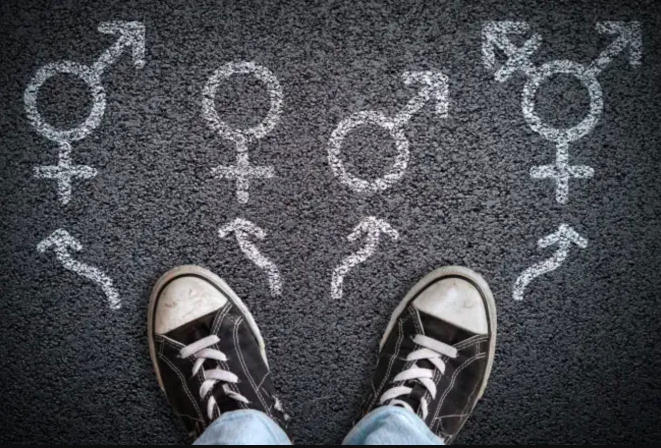Jan Bergstra & Laurens Buijs
Amsterdam Gender Theory Research Team
With formal gender theory(FGT), we try to arrive at a clear narrative of gender theory that involves choices but also avoids, to the best of our ability, the use of language in such a way that some extreme positions cannot even be put into words. Helen Joyce has pointed this out in her book TRANS (see AGTRT-BF88): language can fall short of doing sufficient justice to different points of view.
In AGTRT-BF75, therefore, we proposed that male and female (like gender, transgender, cisgender, gendered, pronoun, sex, and woke) should just be used as Dutch terms, for lack of alternative and because the contrast male/female precisely does not mean the same thing to everyone as the contrast male/female.
We note briefly the exceptionally backward position of the Vatican: gender theory is put down as wrong in Dignitas Infinita (see AGTRT-BT5 and AGTRT-BF77), and not the positions within it that the Vatican opposes. Of course the Vatican is going to lose this battle, if only because the very defense against co-essentialism is itself part of gender theory. You can’t disagree with Kant without being a proponent of philosophy, but even that insight is lost on “Rome.”
Pediatrician Hilary Cass’ report (see AGTRT-BD78) on gender care for adolescents in the United Kingdom states that “social transitioning” is often the first step. Then the person who wants to transition is already going to use the eventually desired gender pronouns, and possibly dress and behave as would fit the desired gender.
From FGT, we are faced with a question here: is social gender a concept that enters theory along this line or is this a description beyond which nothing else should be sought? Below we fit social transition into the body of terminology.
- Gender transition (of a person P) is a process over time that occurs in stages: social transition is one such stage. These phases may overlap in whole or in part.
- Psychological transition (P conceives that a transition is desired and imminent) usually precedes social transition.
- The term transgender is often used for persons who have expressed that they have made the psychologically transition (and then one may still have the social transition and the medical transition ahead of them).
- Sociale transitie (sociale gendertransitie) betreft een fase die kan volgen op de psychologische transitie en waarin P al de bij het gewenste gender voor de hand liggende gender expression (voornaam, pronouns kleding en verzorging van uiterlijk) gaat hanteren.
- Puberty inhibitors can be used to allow more time for social transition (more certainty about the persistence of psychological transition) and delay irreversible steps.
- Medical transition (surgery, hormone treatment) includes interventions and treatments (of little or no reversibility and with significant side effects) that improve gender congruence (and sometimes achieve desired gender congruence). Medical transition is optional in that not every transition process includes a medical transition.
- Formal transition (from person P to gender G, to be chosen from male, female and neutral): formal transition involves (expertly) determining that a person P meets the requirements (under a given concept of formal gender) for “people of gender G”. In formal transition, P can make the move from male to female or vice versa. In formal transition, a male person usually (especially when defined as physical gender via biological characteristics) remains male and a female person remains female. So a trans woman can be male and a trans man can be female. And at this point it also shows the great importance of the availability of the terms male and female in addition to male and female. That interest is explicitly there even if the position is taken that every man is male and woman is female, for following Alex Byrne’s theses AHF and AHM (see AGTRT-1 and AGTRT-6), that insight can then also be put into words so explcitively.
- Legal transition is a final part of the process that also involves updating marital records so that P is also known to the government under the new gender G. It is conceivable that formal gender at the civil registry cannot be continued. From a philosophical perspective, the notion of formal gender then “wins” and it can be observed that P is a woman who unhappily has “man” in the passport.
We understand that for many readers this overview is “too difficult” and that they may find parts of it incorrect or redundant. For the principled co-essentialist, even the use of the term transition is an unfortunate choice because it does not adequately express the fact that this is all about an adaptation of the (psychological, social, medical, formal = philosophical, legal) adaptation of the context to the underlying reality that P is a gendered person.
For TERF ideologues (see AGTRT-BF43), gender transition is a contradiction in terms because they consider it “nonsensical” to distinguish formal gender and legal gender in addition to physical gender. For TEFC ideologues (see AGTRT-BF44), gender transition is not so much impossible as completely undesirable, and the use of language in which gender transition as a social phenomenon can simply be properly discussed and described is also undesirable.
But we seek a middle ground (a MotR approach to gender theory) in which the positions can be properly named and the differences in positions can be referred to as the endorsement of different claims in a common language.
